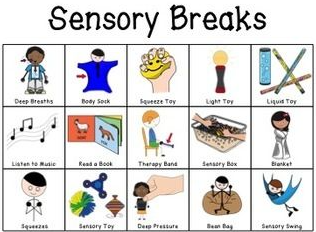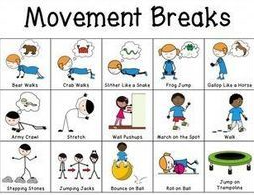Sensory behaviours, their impact and the sensory diet
Observable sensory behaviours
Increased reactions to sensations |
Decreased reactions to sensations |
| Hearing | |
| Is easily distracted by background sounds
Overreacts to sounds Has unpredictable reactions to sounds Holds hands over ears to block noise Screams or cries at sounds in the environment Responds physically as if sound is a threat |
Does not respond to name being spoken
Seems oblivious to sounds of surrounding activities Creates constant sounds as if to stimulate self Does not respond to any kind of sound (check hearing) |
| Seeing | |
| Is disturbed by bright lighting or avoids sunlight
Covers part of visual field- puts hand over part of the page of a book Responds physically to appearance of certain objects or colours |
Is unaware of the presence of other people
Is unable to locate desired objects, people Does not pay attention to visual prompts |
| Touch | |
| Does not like to be touched
Avoids tasks with a strong tactile element (clay, water play, paint, food preparation) Complains about discomfort of clothing, refuses to wear certain clothes Responds negatively to textures in food, toys, Furniture |
Does not seem to notice touch of others
Frequently puts things into mouth Has a high pain threshold, is unaware of danger because of low response to pain |
| Balance and movement | |
| Seems to tire easily when engaged in movement activities
Is generally slow to move, or usually lethargic Takes a long time to respond to directions to move |
Seems to need constant movement
Rocks, jumps |
| Smell and taste | |
| Eats a limited variety of food
Gags, refuses food Spits out foods, medications Overreacts to smells in environment Avoids places or people with strong odours |
Licks objects in the environment
Chews on objects inappropriately May ingest dangerous substances despite their unpleasant taste Sniffs objects and people in unusual ways |
Source: Alberta Learning, Teaching students with Autism Spectrum Disorders. Alberta, Canada. 2003. https://education.alberta.ca/media/512925/autism3.pdf
Consider the following to reduce the impact of sensory factors
Auditory:
Are there fans, loudspeakers, fire alarms, several people talking at once, air conditioners, bells, dogs barking, or scraping?
What are the general sound level and the predictability and repetitiveness of sounds?
What can be done to minimise the negative effect these stimuli may have on the student with ASD in the class?
What is the time typically required by the student to process auditory information and/or to shift attention between auditory stimuli?
Visual:
Are there distracters, such as light, movement, reflection, or background patterns, that affect the student’s ability to attend to the learning activity?
What is the eye level of the student, the position of the teacher in relation to the student, and the distracters that may interfere with attention?
How much time is required to shift visual attention?
What effort is given to reducing the effects of aversive visual stimuli, so that the management of the student’s behaviour is facilitated, and his ability to learn is enhanced?
Tactile:
Are there textures that seem to be abrasive?
Are temperatures appropriate to minimise negative effect on the student?
Does the student demonstrate a need to explore through touch, and yet avoid being touched?
What is the level of ability or defensiveness in the use of certain objects intended to support instruction?
Vestibular:
How is the student’s need to move and exercise accommodated?
What are the individual’s reactions to movement?
How can the student’s program incorporate needed movement without unduly jeopardising the attention and learning of other students in the class?
Gustatory and olfactory:
What are the student’s preferences in taste and smell with foods and other materials?
How are the student’s responses to the smell of materials incorporated into decisions made about activities?
What is the appropriate behaviour, as affected by these smell preferences, suitable to teach for snack or mealtimes?
Sensory diet (sensory experience plan) 
It is an action plan to give a child the sensory experience they may need. Suitable sensory experience provided in supportive settings and predictable routines can help children regulate emotions, prevent overstimulation, and become calm. For children who tend to be under-stimulated, regular sensory stimulation may energise them and make them alert.
Some guiding principles:
- The child should like the sensory experience; it should not be distressing for the child.
- It should combine a variety of experiences.
- It should be easily accessible to the child at school and home.
- At least in the early stages of introducing the sensory experience, the child should be monitored and supported.
- The sensory experience plan should be regularly reviewed, and if something isn’t working, it should be stopped or replaced.
Types of sensory experiences

Tactile
- Playing with beans or pebbles
- Playing with slime, playdough, or clay
- Colouring with hands
- walking bare feet on a rough surface
- squeezing a rough softball
- Making sandcastles
- holding a vibrating toy in hands
- massage
Movement and proprioception

- Jumping running spinning
- Swinging
- Dancing
- hula hoop
- Skipping rope
- Playing catch a ball
- pushing a wheelbarrow
- Lying under cushions
Oral
- Blowing a cotton ball
- eating crunchy food
- making animal sounds
- blowing up balloons
- puffing cheeks with air
- painting while holding the brush in the mouth
- licking a sticky sauce off lips
Visual
- matching games
- pattern activity
- puzzles
- colourful bubbles
Smell
- scented oils
- perfumes
- scented sticks
Sound
- sing songs
- play musical instruments
- noise blocking earmuffs
- listen to calming music
Some examples of the sensory experience plan
#1: A 7-year-old boy with autism and hyperactivity
Starting at a convenient time in the morning, plan for giving the child the experience of one of the following activities for 10 to 30 minutes, one every two hours or so:
- jumping on the trampoline or skipping rope
- blowing up balloons
- lying down under a weighted blanket
- eating some crunchy carrots
- listening to calming music while watching colourful bubbles in the room with incense sticks.
#2: A four-year-old girl who is under stimulated:
Starting at a convenient time in the morning, plan for giving the child the experience of one of the following activities for 10 to 30 minutes, every two hours or so:
- a massage of her arms and legs with pressure
- completing a puzzle
- going on a swing or a merry go round
- rolling on her tummy
- using a vibrating toothbrush
- lying down under a weighted blanket
#3: a 13-year-old boy with anxiety, poor emotional regulation and difficult behaviour
Starting at a convenient time in the morning, plan for giving the child the experience of one of the following activities for 10 to 30 minutes, one every two hours or so:
- Using noise reducing earmuffs or noise cancelling earphones when doing drawing or any other preferred activity
- Playing catching a ball or juggling some balls for 10 minutes
- running for 20 minutes
- Skip rope for 10 minutes
- breathing exercises for 10 minutes
- yoga for 15 minutes

